Public Relations Crisis Management Case Study
VerifiedAdded on 2020/03/23
|11
|2905
|35
AI Summary
This assignment analyzes a public relations crisis involving United Airlines. It examines the PR mistakes made during the incident, particularly concerning passenger eviction and communication. The analysis also recommends strategies to handle such crises effectively, emphasizing ethical considerations, stakeholder engagement, and damage control.
Contribute Materials
Your contribution can guide someone’s learning journey. Share your
documents today.

Running head: PR ERRORS 1
PR Errors
Name
Institution
PR Errors
Name
Institution
Secure Best Marks with AI Grader
Need help grading? Try our AI Grader for instant feedback on your assignments.
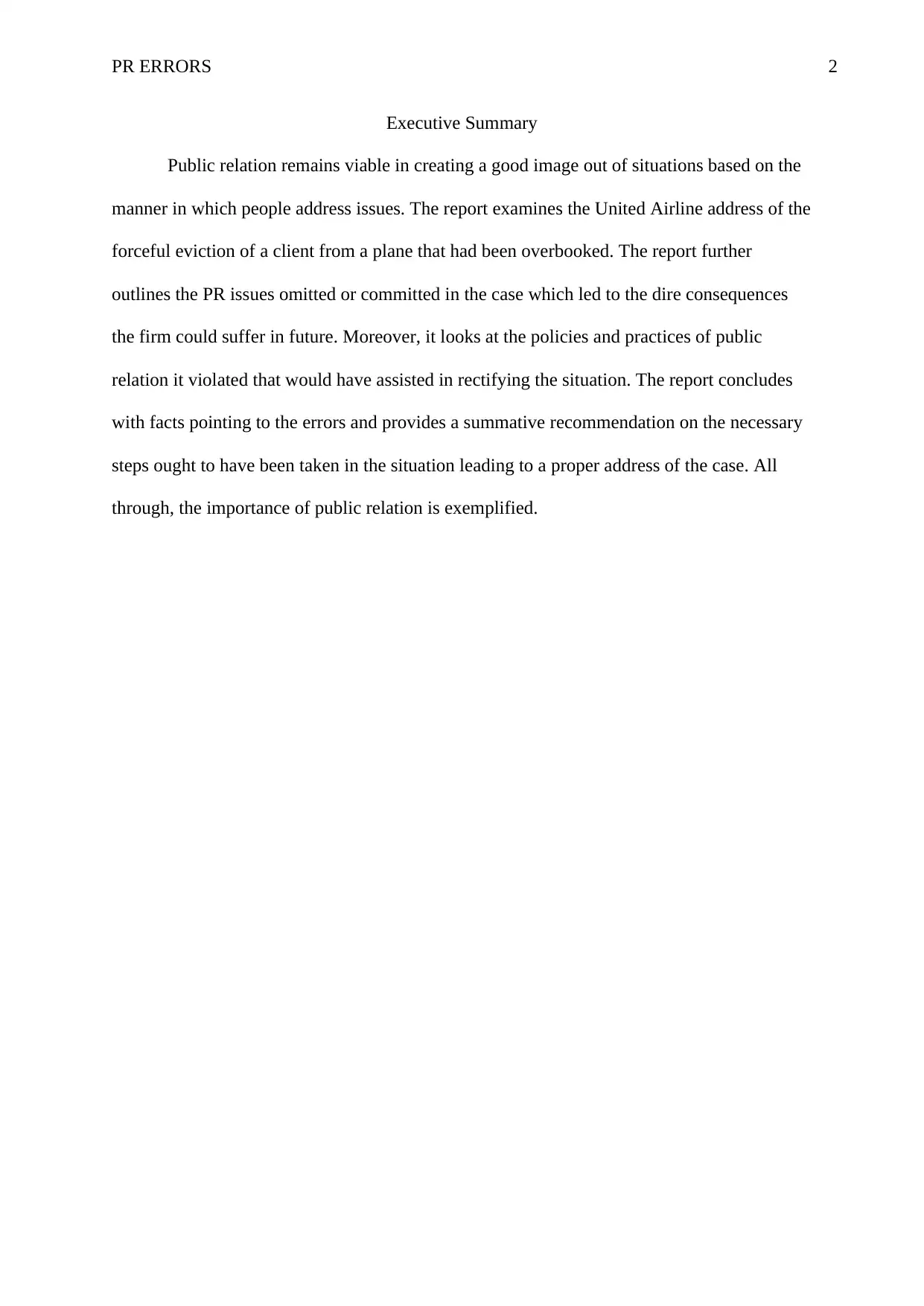
PR ERRORS 2
Executive Summary
Public relation remains viable in creating a good image out of situations based on the
manner in which people address issues. The report examines the United Airline address of the
forceful eviction of a client from a plane that had been overbooked. The report further
outlines the PR issues omitted or committed in the case which led to the dire consequences
the firm could suffer in future. Moreover, it looks at the policies and practices of public
relation it violated that would have assisted in rectifying the situation. The report concludes
with facts pointing to the errors and provides a summative recommendation on the necessary
steps ought to have been taken in the situation leading to a proper address of the case. All
through, the importance of public relation is exemplified.
Executive Summary
Public relation remains viable in creating a good image out of situations based on the
manner in which people address issues. The report examines the United Airline address of the
forceful eviction of a client from a plane that had been overbooked. The report further
outlines the PR issues omitted or committed in the case which led to the dire consequences
the firm could suffer in future. Moreover, it looks at the policies and practices of public
relation it violated that would have assisted in rectifying the situation. The report concludes
with facts pointing to the errors and provides a summative recommendation on the necessary
steps ought to have been taken in the situation leading to a proper address of the case. All
through, the importance of public relation is exemplified.
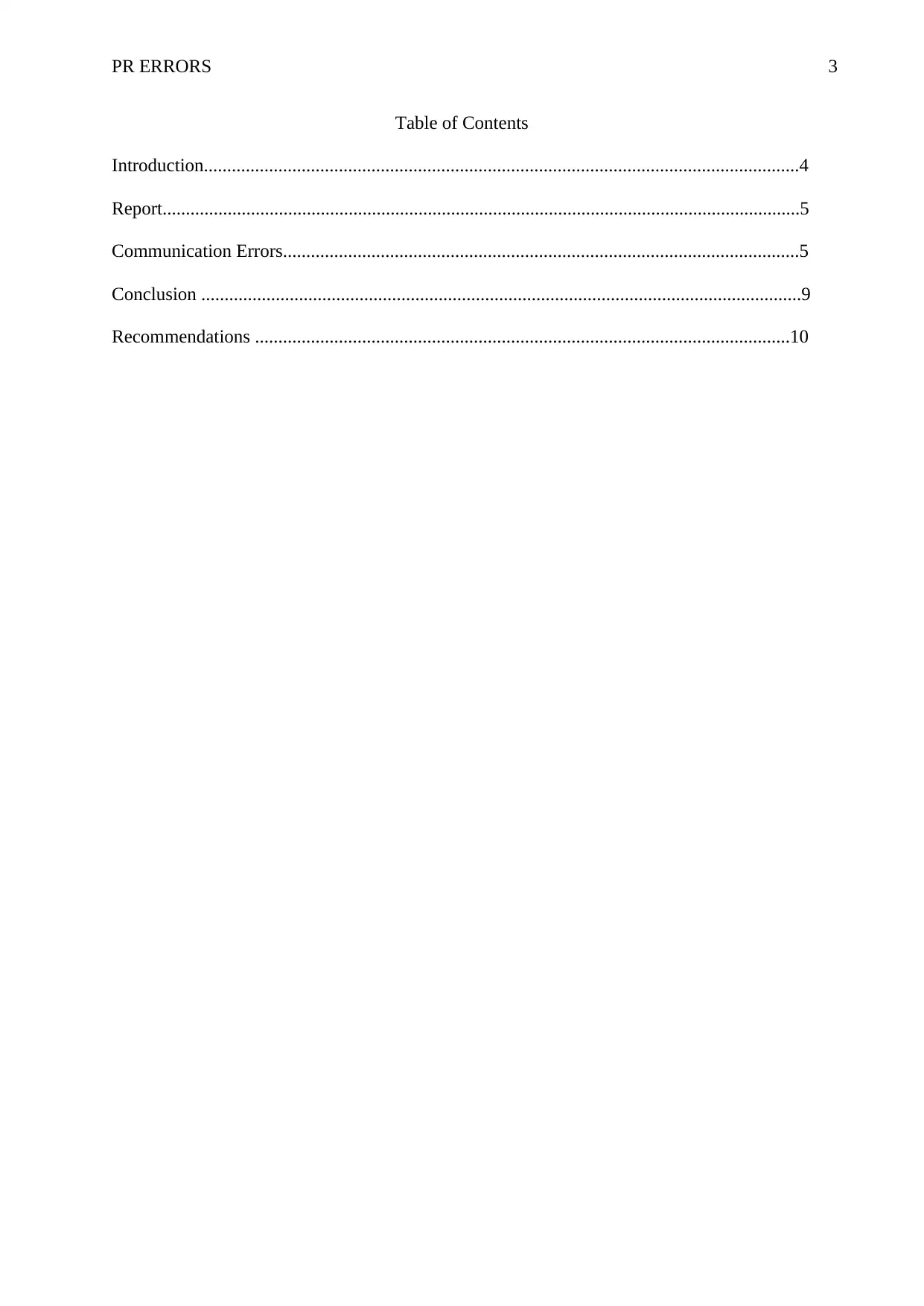
PR ERRORS 3
Table of Contents
Introduction................................................................................................................................4
Report.........................................................................................................................................5
Communication Errors...............................................................................................................5
Conclusion .................................................................................................................................9
Recommendations ...................................................................................................................10
Table of Contents
Introduction................................................................................................................................4
Report.........................................................................................................................................5
Communication Errors...............................................................................................................5
Conclusion .................................................................................................................................9
Recommendations ...................................................................................................................10

PR ERRORS 4
United Airline’s PR Errors
Introduction
Public relation is a superior tool towards convincing individuals and portraying the
right image to persons in a given situation to increase or protect the reputation of a company
or a product. The practice is used by managers, individuals, and talk experts in driving a
positive image whenever engaged in a crisis or discussions with clients as it seeks to create a
good rapport with people. Public relation works by getting the attention of individuals to a
given issue, stimulating their interest towards a given matter thus creating the desire and
intention for them to act and take part in a decision process.
As such, it remains a voluntary action which targets a specific objective where the
participants are not forced into an action but rather persuaded into one. Failure to observe
proper public relation practices can result in failures and a possible distortion of reputation
which leads to the creation of a negative impact on an organization. The case looks at the PR
failures registered in the event where the United Airline forcefully removed a passenger, Dr.
Dao from a flight awaiting departure due to overbooking.
United Airline’s PR Errors
Introduction
Public relation is a superior tool towards convincing individuals and portraying the
right image to persons in a given situation to increase or protect the reputation of a company
or a product. The practice is used by managers, individuals, and talk experts in driving a
positive image whenever engaged in a crisis or discussions with clients as it seeks to create a
good rapport with people. Public relation works by getting the attention of individuals to a
given issue, stimulating their interest towards a given matter thus creating the desire and
intention for them to act and take part in a decision process.
As such, it remains a voluntary action which targets a specific objective where the
participants are not forced into an action but rather persuaded into one. Failure to observe
proper public relation practices can result in failures and a possible distortion of reputation
which leads to the creation of a negative impact on an organization. The case looks at the PR
failures registered in the event where the United Airline forcefully removed a passenger, Dr.
Dao from a flight awaiting departure due to overbooking.
Secure Best Marks with AI Grader
Need help grading? Try our AI Grader for instant feedback on your assignments.
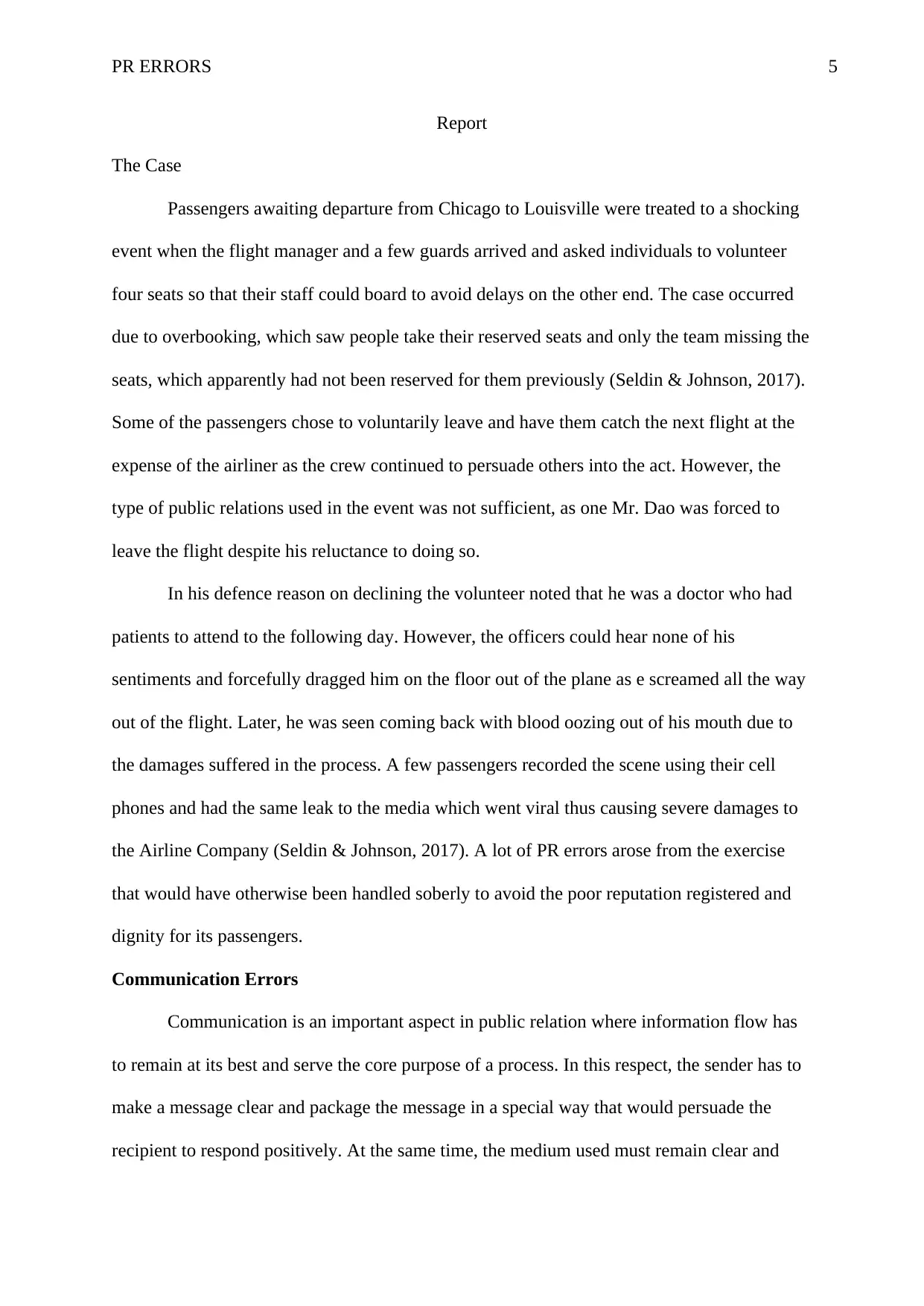
PR ERRORS 5
Report
The Case
Passengers awaiting departure from Chicago to Louisville were treated to a shocking
event when the flight manager and a few guards arrived and asked individuals to volunteer
four seats so that their staff could board to avoid delays on the other end. The case occurred
due to overbooking, which saw people take their reserved seats and only the team missing the
seats, which apparently had not been reserved for them previously (Seldin & Johnson, 2017).
Some of the passengers chose to voluntarily leave and have them catch the next flight at the
expense of the airliner as the crew continued to persuade others into the act. However, the
type of public relations used in the event was not sufficient, as one Mr. Dao was forced to
leave the flight despite his reluctance to doing so.
In his defence reason on declining the volunteer noted that he was a doctor who had
patients to attend to the following day. However, the officers could hear none of his
sentiments and forcefully dragged him on the floor out of the plane as e screamed all the way
out of the flight. Later, he was seen coming back with blood oozing out of his mouth due to
the damages suffered in the process. A few passengers recorded the scene using their cell
phones and had the same leak to the media which went viral thus causing severe damages to
the Airline Company (Seldin & Johnson, 2017). A lot of PR errors arose from the exercise
that would have otherwise been handled soberly to avoid the poor reputation registered and
dignity for its passengers.
Communication Errors
Communication is an important aspect in public relation where information flow has
to remain at its best and serve the core purpose of a process. In this respect, the sender has to
make a message clear and package the message in a special way that would persuade the
recipient to respond positively. At the same time, the medium used must remain clear and
Report
The Case
Passengers awaiting departure from Chicago to Louisville were treated to a shocking
event when the flight manager and a few guards arrived and asked individuals to volunteer
four seats so that their staff could board to avoid delays on the other end. The case occurred
due to overbooking, which saw people take their reserved seats and only the team missing the
seats, which apparently had not been reserved for them previously (Seldin & Johnson, 2017).
Some of the passengers chose to voluntarily leave and have them catch the next flight at the
expense of the airliner as the crew continued to persuade others into the act. However, the
type of public relations used in the event was not sufficient, as one Mr. Dao was forced to
leave the flight despite his reluctance to doing so.
In his defence reason on declining the volunteer noted that he was a doctor who had
patients to attend to the following day. However, the officers could hear none of his
sentiments and forcefully dragged him on the floor out of the plane as e screamed all the way
out of the flight. Later, he was seen coming back with blood oozing out of his mouth due to
the damages suffered in the process. A few passengers recorded the scene using their cell
phones and had the same leak to the media which went viral thus causing severe damages to
the Airline Company (Seldin & Johnson, 2017). A lot of PR errors arose from the exercise
that would have otherwise been handled soberly to avoid the poor reputation registered and
dignity for its passengers.
Communication Errors
Communication is an important aspect in public relation where information flow has
to remain at its best and serve the core purpose of a process. In this respect, the sender has to
make a message clear and package the message in a special way that would persuade the
recipient to respond positively. At the same time, the medium used must remain clear and
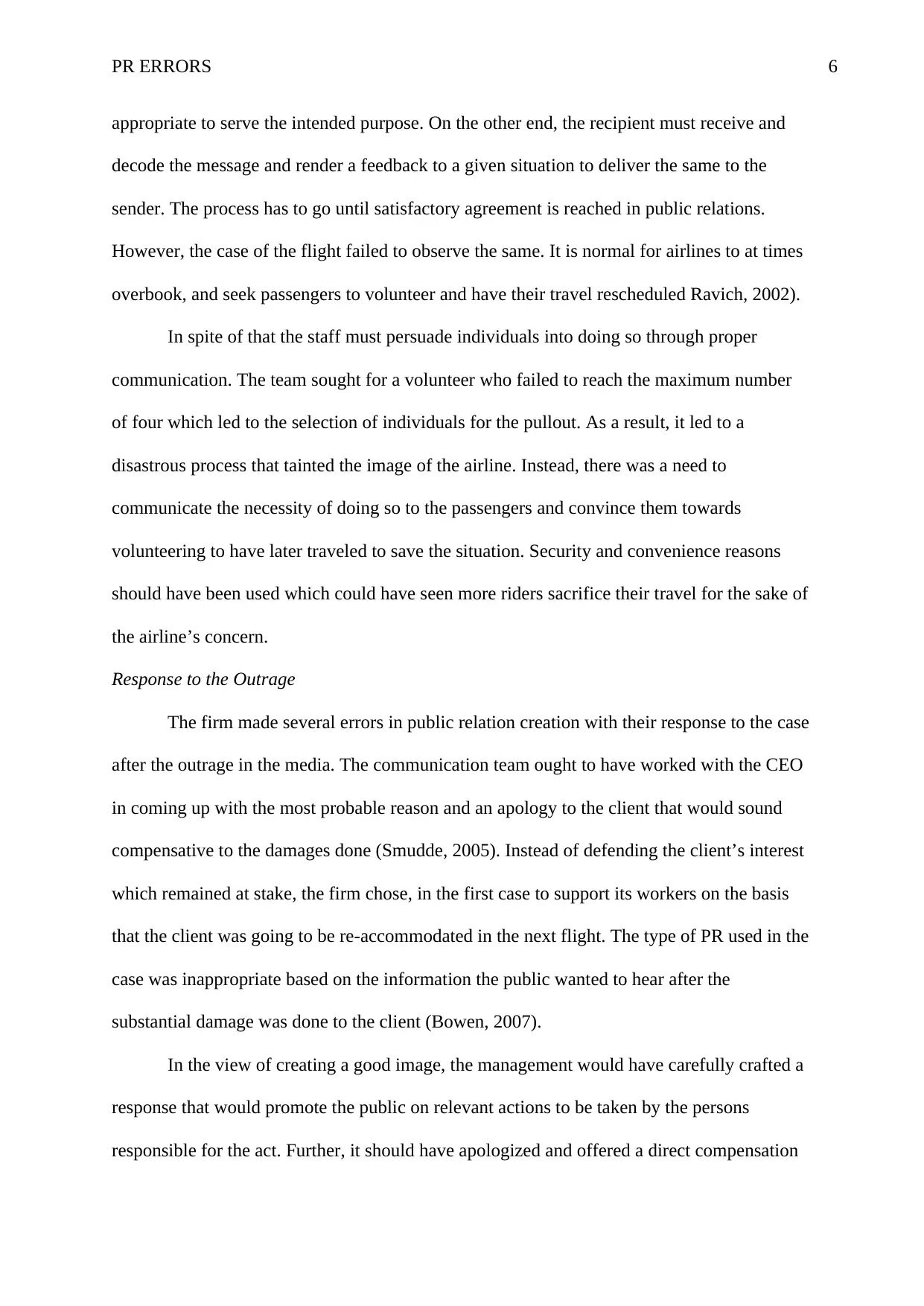
PR ERRORS 6
appropriate to serve the intended purpose. On the other end, the recipient must receive and
decode the message and render a feedback to a given situation to deliver the same to the
sender. The process has to go until satisfactory agreement is reached in public relations.
However, the case of the flight failed to observe the same. It is normal for airlines to at times
overbook, and seek passengers to volunteer and have their travel rescheduled Ravich, 2002).
In spite of that the staff must persuade individuals into doing so through proper
communication. The team sought for a volunteer who failed to reach the maximum number
of four which led to the selection of individuals for the pullout. As a result, it led to a
disastrous process that tainted the image of the airline. Instead, there was a need to
communicate the necessity of doing so to the passengers and convince them towards
volunteering to have later traveled to save the situation. Security and convenience reasons
should have been used which could have seen more riders sacrifice their travel for the sake of
the airline’s concern.
Response to the Outrage
The firm made several errors in public relation creation with their response to the case
after the outrage in the media. The communication team ought to have worked with the CEO
in coming up with the most probable reason and an apology to the client that would sound
compensative to the damages done (Smudde, 2005). Instead of defending the client’s interest
which remained at stake, the firm chose, in the first case to support its workers on the basis
that the client was going to be re-accommodated in the next flight. The type of PR used in the
case was inappropriate based on the information the public wanted to hear after the
substantial damage was done to the client (Bowen, 2007).
In the view of creating a good image, the management would have carefully crafted a
response that would promote the public on relevant actions to be taken by the persons
responsible for the act. Further, it should have apologized and offered a direct compensation
appropriate to serve the intended purpose. On the other end, the recipient must receive and
decode the message and render a feedback to a given situation to deliver the same to the
sender. The process has to go until satisfactory agreement is reached in public relations.
However, the case of the flight failed to observe the same. It is normal for airlines to at times
overbook, and seek passengers to volunteer and have their travel rescheduled Ravich, 2002).
In spite of that the staff must persuade individuals into doing so through proper
communication. The team sought for a volunteer who failed to reach the maximum number
of four which led to the selection of individuals for the pullout. As a result, it led to a
disastrous process that tainted the image of the airline. Instead, there was a need to
communicate the necessity of doing so to the passengers and convince them towards
volunteering to have later traveled to save the situation. Security and convenience reasons
should have been used which could have seen more riders sacrifice their travel for the sake of
the airline’s concern.
Response to the Outrage
The firm made several errors in public relation creation with their response to the case
after the outrage in the media. The communication team ought to have worked with the CEO
in coming up with the most probable reason and an apology to the client that would sound
compensative to the damages done (Smudde, 2005). Instead of defending the client’s interest
which remained at stake, the firm chose, in the first case to support its workers on the basis
that the client was going to be re-accommodated in the next flight. The type of PR used in the
case was inappropriate based on the information the public wanted to hear after the
substantial damage was done to the client (Bowen, 2007).
In the view of creating a good image, the management would have carefully crafted a
response that would promote the public on relevant actions to be taken by the persons
responsible for the act. Further, it should have apologized and offered a direct compensation

PR ERRORS 7
in a bid to remove the wrong impression registered. In so doing, the management would be
promising its client of excellent service by dissociating itself from the act of the security
personnel and the manager who called in to have the passenger dragged (Berger, 2015). Self-
defence in a time where the need for concern for the passenger is necessary distorts the public
image of firms, and, thus acts negatively in such a situation.
Persuasion versus Manipulation
Persuasion refers to the attempt to influence an individual’s action through the act of
an appeal meant to lure individuals into a specific act or response. On the other hand,
manipulation theory refers to the act of coercion aimed at tricking or forcefully driving an
audience into an act which can end up in loss of credibility. The theory is relevant towards
the situation of the passenger being pulled out of the airline after failing to volunteer the seat
for the staff that was catching the flight to avoid delays on the other end of work.
Instead of persuading and respecting the reasons and decision of the passenger, Mr.
Dao, the security officer, called in by the manager decided to use forceful means which
amount to the theory of manipulation after failing to sacrifice the seat for the staff (Grunig,
2013). The case resulted from the absolute error of overbooking, which, in any way was not
the mistake of the passengers. In such a case, there was a need to communicate the issue with
the passengers and seek their consent, through an appeal to have the situation rectified.
Therefore, the theory of manipulation occurred rather than the persuasion which would have
prevented the public relation error from happening.
Management Address to the Issue
In response, the CEO of the airline Oscar Munoz shared their sentiments and
apologized for the event noting that no one deserves the type of treatment registered. At the
same time, he promised to take full responsibility for the matter and approach all relevant
channels towards rectifying and preventing similar occurrences in the future. He pledged to
in a bid to remove the wrong impression registered. In so doing, the management would be
promising its client of excellent service by dissociating itself from the act of the security
personnel and the manager who called in to have the passenger dragged (Berger, 2015). Self-
defence in a time where the need for concern for the passenger is necessary distorts the public
image of firms, and, thus acts negatively in such a situation.
Persuasion versus Manipulation
Persuasion refers to the attempt to influence an individual’s action through the act of
an appeal meant to lure individuals into a specific act or response. On the other hand,
manipulation theory refers to the act of coercion aimed at tricking or forcefully driving an
audience into an act which can end up in loss of credibility. The theory is relevant towards
the situation of the passenger being pulled out of the airline after failing to volunteer the seat
for the staff that was catching the flight to avoid delays on the other end of work.
Instead of persuading and respecting the reasons and decision of the passenger, Mr.
Dao, the security officer, called in by the manager decided to use forceful means which
amount to the theory of manipulation after failing to sacrifice the seat for the staff (Grunig,
2013). The case resulted from the absolute error of overbooking, which, in any way was not
the mistake of the passengers. In such a case, there was a need to communicate the issue with
the passengers and seek their consent, through an appeal to have the situation rectified.
Therefore, the theory of manipulation occurred rather than the persuasion which would have
prevented the public relation error from happening.
Management Address to the Issue
In response, the CEO of the airline Oscar Munoz shared their sentiments and
apologized for the event noting that no one deserves the type of treatment registered. At the
same time, he promised to take full responsibility for the matter and approach all relevant
channels towards rectifying and preventing similar occurrences in the future. He pledged to
Paraphrase This Document
Need a fresh take? Get an instant paraphrase of this document with our AI Paraphraser
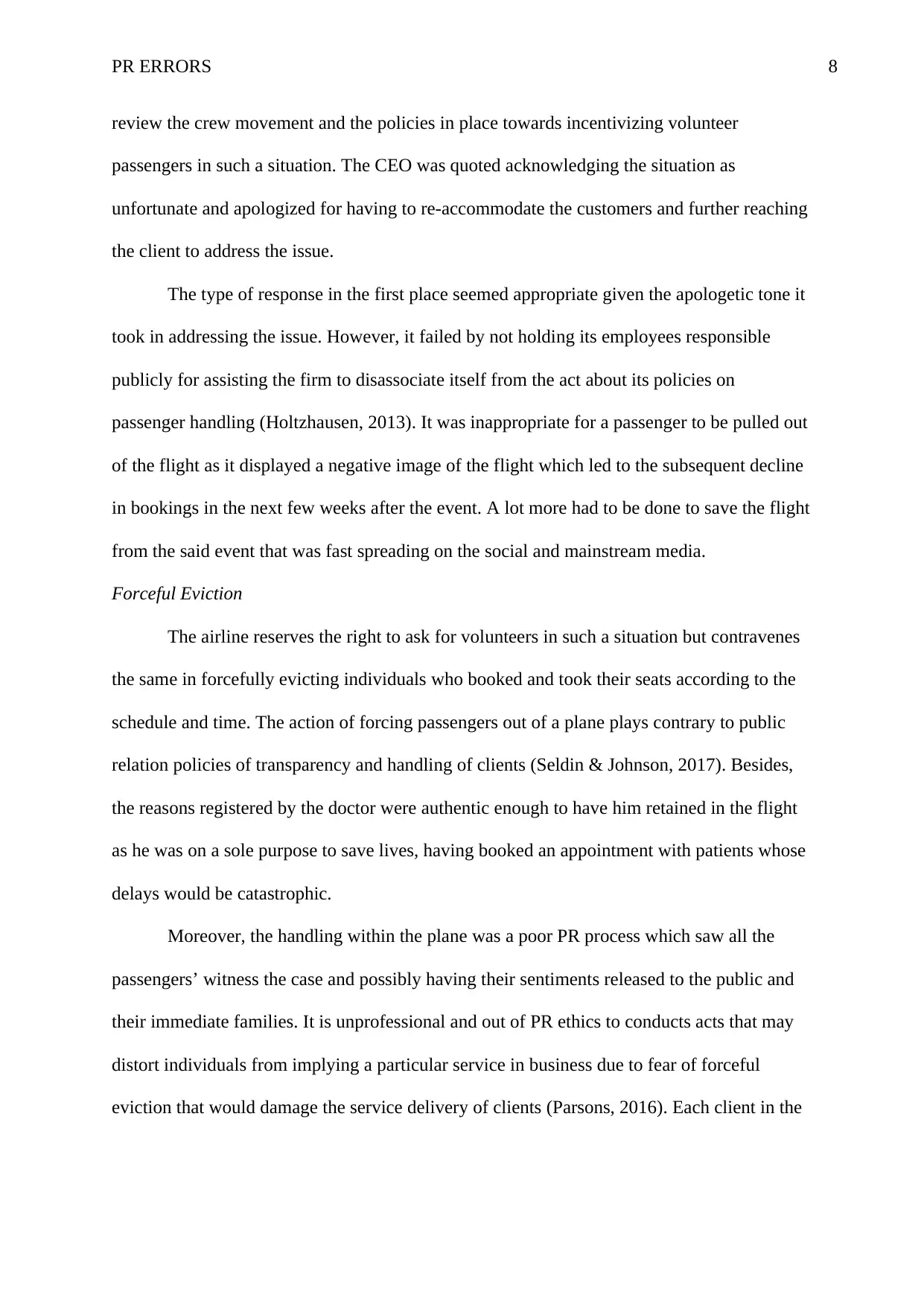
PR ERRORS 8
review the crew movement and the policies in place towards incentivizing volunteer
passengers in such a situation. The CEO was quoted acknowledging the situation as
unfortunate and apologized for having to re-accommodate the customers and further reaching
the client to address the issue.
The type of response in the first place seemed appropriate given the apologetic tone it
took in addressing the issue. However, it failed by not holding its employees responsible
publicly for assisting the firm to disassociate itself from the act about its policies on
passenger handling (Holtzhausen, 2013). It was inappropriate for a passenger to be pulled out
of the flight as it displayed a negative image of the flight which led to the subsequent decline
in bookings in the next few weeks after the event. A lot more had to be done to save the flight
from the said event that was fast spreading on the social and mainstream media.
Forceful Eviction
The airline reserves the right to ask for volunteers in such a situation but contravenes
the same in forcefully evicting individuals who booked and took their seats according to the
schedule and time. The action of forcing passengers out of a plane plays contrary to public
relation policies of transparency and handling of clients (Seldin & Johnson, 2017). Besides,
the reasons registered by the doctor were authentic enough to have him retained in the flight
as he was on a sole purpose to save lives, having booked an appointment with patients whose
delays would be catastrophic.
Moreover, the handling within the plane was a poor PR process which saw all the
passengers’ witness the case and possibly having their sentiments released to the public and
their immediate families. It is unprofessional and out of PR ethics to conducts acts that may
distort individuals from implying a particular service in business due to fear of forceful
eviction that would damage the service delivery of clients (Parsons, 2016). Each client in the
review the crew movement and the policies in place towards incentivizing volunteer
passengers in such a situation. The CEO was quoted acknowledging the situation as
unfortunate and apologized for having to re-accommodate the customers and further reaching
the client to address the issue.
The type of response in the first place seemed appropriate given the apologetic tone it
took in addressing the issue. However, it failed by not holding its employees responsible
publicly for assisting the firm to disassociate itself from the act about its policies on
passenger handling (Holtzhausen, 2013). It was inappropriate for a passenger to be pulled out
of the flight as it displayed a negative image of the flight which led to the subsequent decline
in bookings in the next few weeks after the event. A lot more had to be done to save the flight
from the said event that was fast spreading on the social and mainstream media.
Forceful Eviction
The airline reserves the right to ask for volunteers in such a situation but contravenes
the same in forcefully evicting individuals who booked and took their seats according to the
schedule and time. The action of forcing passengers out of a plane plays contrary to public
relation policies of transparency and handling of clients (Seldin & Johnson, 2017). Besides,
the reasons registered by the doctor were authentic enough to have him retained in the flight
as he was on a sole purpose to save lives, having booked an appointment with patients whose
delays would be catastrophic.
Moreover, the handling within the plane was a poor PR process which saw all the
passengers’ witness the case and possibly having their sentiments released to the public and
their immediate families. It is unprofessional and out of PR ethics to conducts acts that may
distort individuals from implying a particular service in business due to fear of forceful
eviction that would damage the service delivery of clients (Parsons, 2016). Each client in the
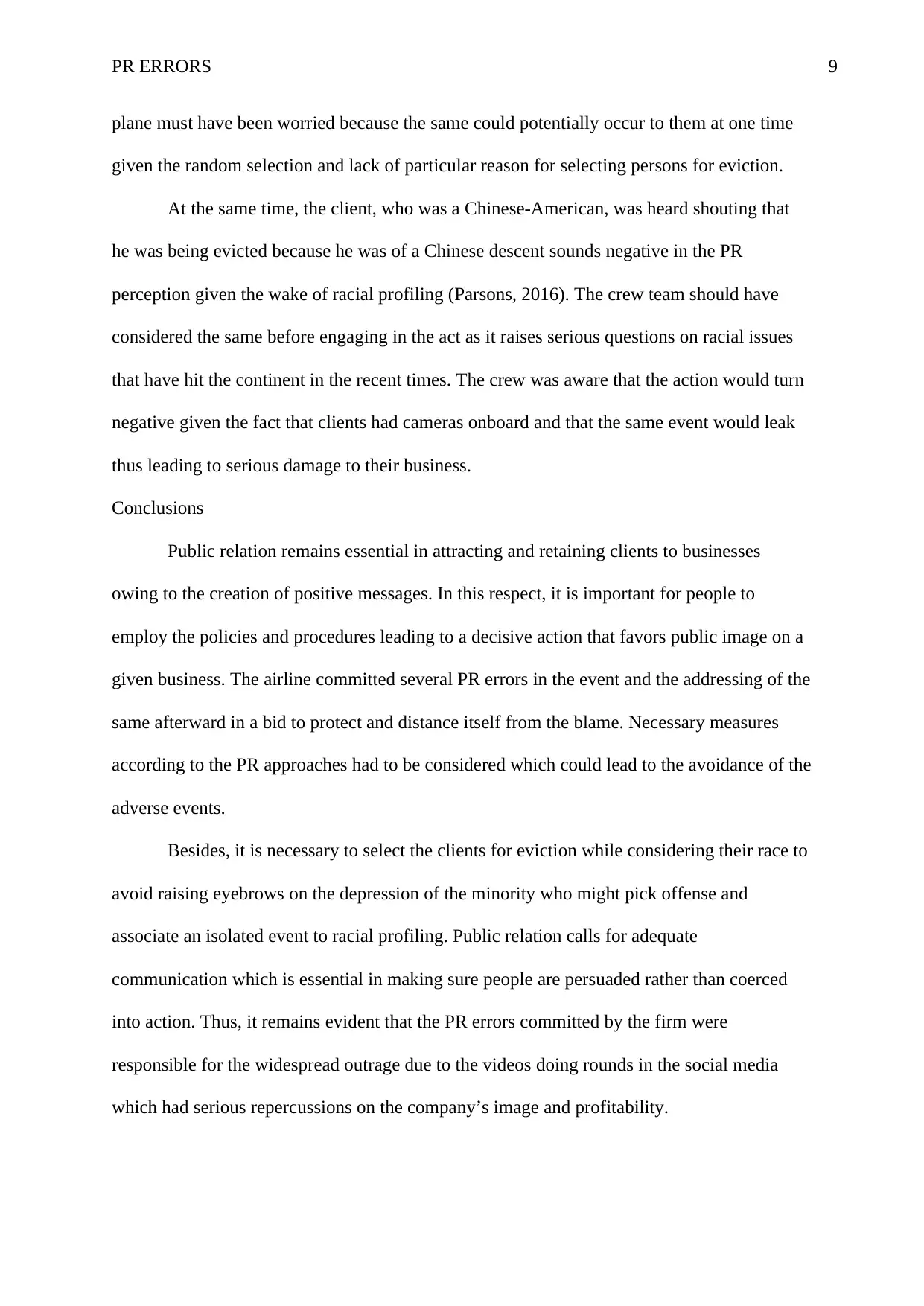
PR ERRORS 9
plane must have been worried because the same could potentially occur to them at one time
given the random selection and lack of particular reason for selecting persons for eviction.
At the same time, the client, who was a Chinese-American, was heard shouting that
he was being evicted because he was of a Chinese descent sounds negative in the PR
perception given the wake of racial profiling (Parsons, 2016). The crew team should have
considered the same before engaging in the act as it raises serious questions on racial issues
that have hit the continent in the recent times. The crew was aware that the action would turn
negative given the fact that clients had cameras onboard and that the same event would leak
thus leading to serious damage to their business.
Conclusions
Public relation remains essential in attracting and retaining clients to businesses
owing to the creation of positive messages. In this respect, it is important for people to
employ the policies and procedures leading to a decisive action that favors public image on a
given business. The airline committed several PR errors in the event and the addressing of the
same afterward in a bid to protect and distance itself from the blame. Necessary measures
according to the PR approaches had to be considered which could lead to the avoidance of the
adverse events.
Besides, it is necessary to select the clients for eviction while considering their race to
avoid raising eyebrows on the depression of the minority who might pick offense and
associate an isolated event to racial profiling. Public relation calls for adequate
communication which is essential in making sure people are persuaded rather than coerced
into action. Thus, it remains evident that the PR errors committed by the firm were
responsible for the widespread outrage due to the videos doing rounds in the social media
which had serious repercussions on the company’s image and profitability.
plane must have been worried because the same could potentially occur to them at one time
given the random selection and lack of particular reason for selecting persons for eviction.
At the same time, the client, who was a Chinese-American, was heard shouting that
he was being evicted because he was of a Chinese descent sounds negative in the PR
perception given the wake of racial profiling (Parsons, 2016). The crew team should have
considered the same before engaging in the act as it raises serious questions on racial issues
that have hit the continent in the recent times. The crew was aware that the action would turn
negative given the fact that clients had cameras onboard and that the same event would leak
thus leading to serious damage to their business.
Conclusions
Public relation remains essential in attracting and retaining clients to businesses
owing to the creation of positive messages. In this respect, it is important for people to
employ the policies and procedures leading to a decisive action that favors public image on a
given business. The airline committed several PR errors in the event and the addressing of the
same afterward in a bid to protect and distance itself from the blame. Necessary measures
according to the PR approaches had to be considered which could lead to the avoidance of the
adverse events.
Besides, it is necessary to select the clients for eviction while considering their race to
avoid raising eyebrows on the depression of the minority who might pick offense and
associate an isolated event to racial profiling. Public relation calls for adequate
communication which is essential in making sure people are persuaded rather than coerced
into action. Thus, it remains evident that the PR errors committed by the firm were
responsible for the widespread outrage due to the videos doing rounds in the social media
which had serious repercussions on the company’s image and profitability.
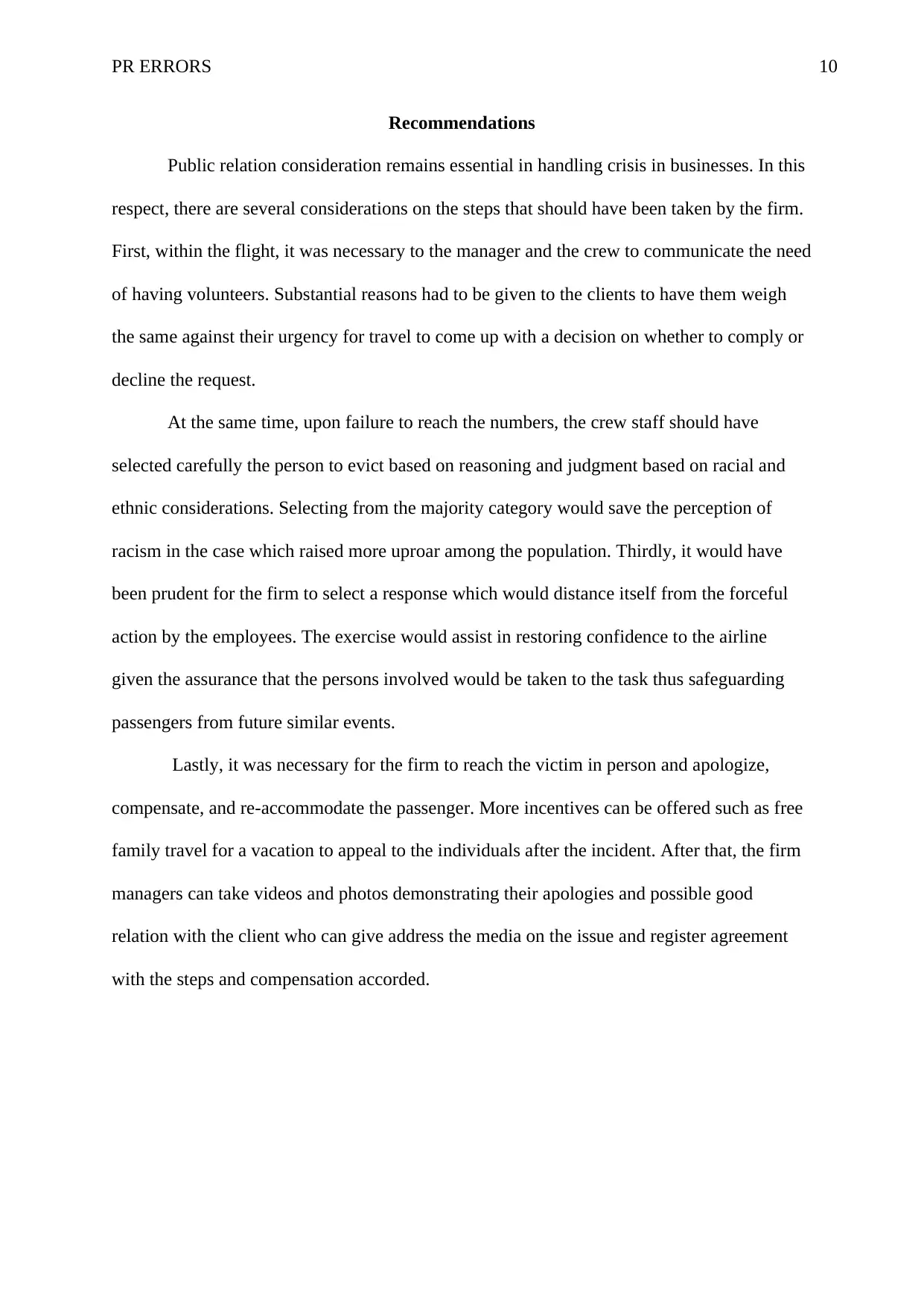
PR ERRORS 10
Recommendations
Public relation consideration remains essential in handling crisis in businesses. In this
respect, there are several considerations on the steps that should have been taken by the firm.
First, within the flight, it was necessary to the manager and the crew to communicate the need
of having volunteers. Substantial reasons had to be given to the clients to have them weigh
the same against their urgency for travel to come up with a decision on whether to comply or
decline the request.
At the same time, upon failure to reach the numbers, the crew staff should have
selected carefully the person to evict based on reasoning and judgment based on racial and
ethnic considerations. Selecting from the majority category would save the perception of
racism in the case which raised more uproar among the population. Thirdly, it would have
been prudent for the firm to select a response which would distance itself from the forceful
action by the employees. The exercise would assist in restoring confidence to the airline
given the assurance that the persons involved would be taken to the task thus safeguarding
passengers from future similar events.
Lastly, it was necessary for the firm to reach the victim in person and apologize,
compensate, and re-accommodate the passenger. More incentives can be offered such as free
family travel for a vacation to appeal to the individuals after the incident. After that, the firm
managers can take videos and photos demonstrating their apologies and possible good
relation with the client who can give address the media on the issue and register agreement
with the steps and compensation accorded.
Recommendations
Public relation consideration remains essential in handling crisis in businesses. In this
respect, there are several considerations on the steps that should have been taken by the firm.
First, within the flight, it was necessary to the manager and the crew to communicate the need
of having volunteers. Substantial reasons had to be given to the clients to have them weigh
the same against their urgency for travel to come up with a decision on whether to comply or
decline the request.
At the same time, upon failure to reach the numbers, the crew staff should have
selected carefully the person to evict based on reasoning and judgment based on racial and
ethnic considerations. Selecting from the majority category would save the perception of
racism in the case which raised more uproar among the population. Thirdly, it would have
been prudent for the firm to select a response which would distance itself from the forceful
action by the employees. The exercise would assist in restoring confidence to the airline
given the assurance that the persons involved would be taken to the task thus safeguarding
passengers from future similar events.
Lastly, it was necessary for the firm to reach the victim in person and apologize,
compensate, and re-accommodate the passenger. More incentives can be offered such as free
family travel for a vacation to appeal to the individuals after the incident. After that, the firm
managers can take videos and photos demonstrating their apologies and possible good
relation with the client who can give address the media on the issue and register agreement
with the steps and compensation accorded.
Secure Best Marks with AI Grader
Need help grading? Try our AI Grader for instant feedback on your assignments.
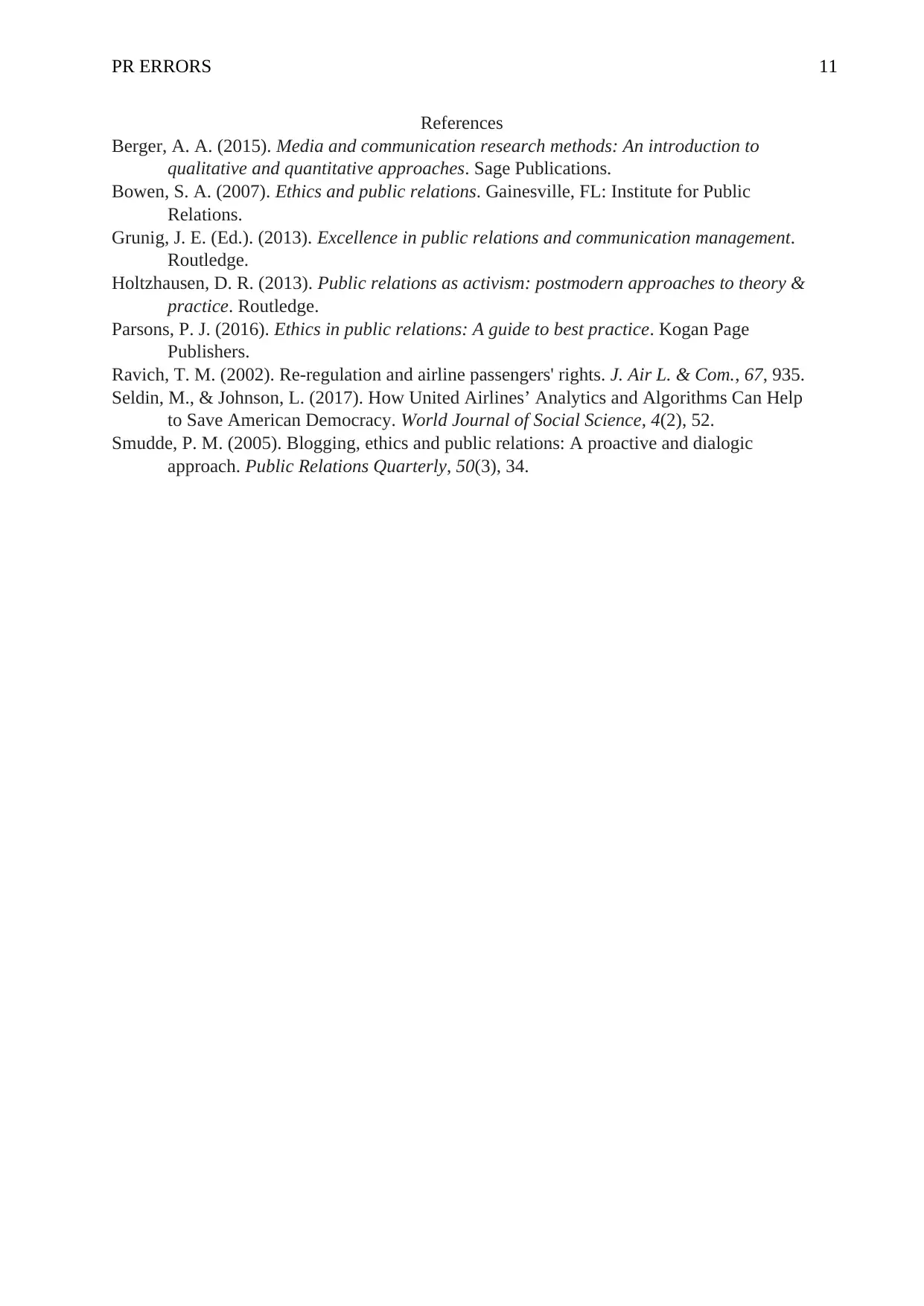
PR ERRORS 11
References
Berger, A. A. (2015). Media and communication research methods: An introduction to
qualitative and quantitative approaches. Sage Publications.
Bowen, S. A. (2007). Ethics and public relations. Gainesville, FL: Institute for Public
Relations.
Grunig, J. E. (Ed.). (2013). Excellence in public relations and communication management.
Routledge.
Holtzhausen, D. R. (2013). Public relations as activism: postmodern approaches to theory &
practice. Routledge.
Parsons, P. J. (2016). Ethics in public relations: A guide to best practice. Kogan Page
Publishers.
Ravich, T. M. (2002). Re-regulation and airline passengers' rights. J. Air L. & Com., 67, 935.
Seldin, M., & Johnson, L. (2017). How United Airlines’ Analytics and Algorithms Can Help
to Save American Democracy. World Journal of Social Science, 4(2), 52.
Smudde, P. M. (2005). Blogging, ethics and public relations: A proactive and dialogic
approach. Public Relations Quarterly, 50(3), 34.
References
Berger, A. A. (2015). Media and communication research methods: An introduction to
qualitative and quantitative approaches. Sage Publications.
Bowen, S. A. (2007). Ethics and public relations. Gainesville, FL: Institute for Public
Relations.
Grunig, J. E. (Ed.). (2013). Excellence in public relations and communication management.
Routledge.
Holtzhausen, D. R. (2013). Public relations as activism: postmodern approaches to theory &
practice. Routledge.
Parsons, P. J. (2016). Ethics in public relations: A guide to best practice. Kogan Page
Publishers.
Ravich, T. M. (2002). Re-regulation and airline passengers' rights. J. Air L. & Com., 67, 935.
Seldin, M., & Johnson, L. (2017). How United Airlines’ Analytics and Algorithms Can Help
to Save American Democracy. World Journal of Social Science, 4(2), 52.
Smudde, P. M. (2005). Blogging, ethics and public relations: A proactive and dialogic
approach. Public Relations Quarterly, 50(3), 34.
1 out of 11
Related Documents
Your All-in-One AI-Powered Toolkit for Academic Success.
+13062052269
info@desklib.com
Available 24*7 on WhatsApp / Email
![[object Object]](/_next/static/media/star-bottom.7253800d.svg)
Unlock your academic potential
© 2024 | Zucol Services PVT LTD | All rights reserved.





